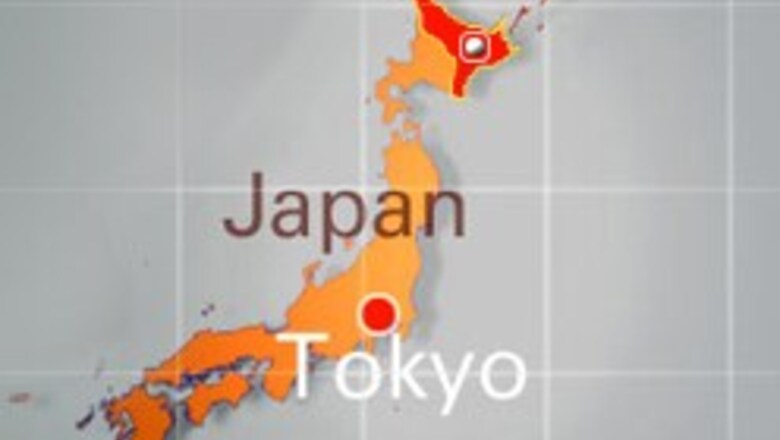
views
Tokyo: A powerful undersea earthquake prompted tsunami warnings on Wednesday for Japan and Russia but the danger appeared to pass after a series of tiny waves hit the northern Japanese coast.
The waves did not swell higher than 16 inches and rapidly diminished in size, but Japan's meteorological agency said that it would wait for at least several hours before withdrawing its warning of possible larger waves.
The agency told coast residents to flee to higher ground after initially predicting that a 6½-foot tsunami would hit the Pacific coast of its northernmost island of Hokkaido and main island of Honshu after 2110 hrs local time (1210 hrs GMT).
A wave that hit the port of Nemuro on Hokkaido at 2129 hrs local time was measured at 16 inches, and live footage from the area showed calm seas. A few minutes later, a second, eight-inch wave hit the nearby port city of Kushiro, the agency said, and the waves got progressively smaller.
A magnitude 9.1-magnitude earthquake off the coast of Indonesia on December 26, 2004 caused tsunami as high as 33 feet that killed at least 213,000 people in 11 countries.
Chief of the Japanese meteorological agency's earthquake and tsunami monitoring section, Takeshi Hachimine, said aftershocks of Wednesday's quake could trigger more tsunami - but those waves are expected to pose little danger to Japan.
The quake struck at 6:15 am EST with a preliminary magnitude of 8.1 about 245 miles east of the island known in Japan as Etorofu, which is about 110 miles northeast of Hokkaido, according to the Japanese meteorological agency.
Etorofu is one of four islands claimed by both Japan and Russia. The disputed islands are known in Russia as the Southern Kurils and in Japan as the Northern Territories. Etorofu is known in Russia as Iturup.
A tsunami warning was issued for the Kurils and Sakhalin, a large island that lies between the Kuril chain and Russia's eastern coast, but was later lifted.
Residents in the sparsely poulated Kurils were warned of the threat but were not evacuated and no damage or casualties were reported in Russia as a result of the quake, chief spokewoman for the Emergency Situations Ministry branch in the Sakhalin region, which includes the Kuril Islands, Olga Shekhovtseva said.
The islands have rich natural resources but their population has plummeted to just 9,900, according to official statistics.
PAGE_BREAK
The ITAR-Tass agency reported that Russia's Pacific Fleet ships took refuge at their bases but were ready to help with rescue operations if necessary.
A tsunami warning was in effect on the coastal areas of Alaska, and the Alaska Tsunami Warning Center advised people in low-lying coastal areas to be alert to instructions from local officials. It said people on beaches in the warning area should move to higher ground.
A tsunami watch was in effect for Hawaii, where the Pacific Tsunami Warning Center was investigating whether there was a threat to the state. The center said that any tsunami waves would reach Hawaii at around 7:20 am (12:20 pm EST).
A watch was in effect for the northern tip of British Columbia, and precautionary advisories were issued for coastal areas in Washington, Oregon and California.
An official from the Japanese town of Shibetsu on Hokkaido, Kiyoshi Takimoto, told public broadcaster NHK that about 4,000 of the town's 6,100 residents lived along the coast and had been told to flee to higher ground.
Takimoto said he didn't notice the quake. There were no immediate reports of damage or injuries, according to NHK.
In the city of Kushiro, fire department and city officials urged residents to move to safety, city official Masatoshi Sato said. Railway officials ordered local trains on Hokkaido to stop at nearby stations as a precautionary step, NHK said.
The US Geological Survey reported on its website that a 7.8-magnitude quake had been detected 275 miles east-northeast of the Kurils at a depth of 17.2 miles. Temblors of magnitude seven are generally classified as major earthquakes, capable of widespread, heavy damage.
Tsunami waves, which are generated by earthquakes, are often barely noticeable in the ocean but can rise to great heights once they arrive at shore.
Japan is one of the world's most earthquake-prone countries because it sits atop four tectonic plates.
The Southern Kurils islands were occupied by the Soviet Union in the closing days of World War II. They are surrounded by rich fishing waters and are believed to have promising offshore oil and natural gas reserves. They also have gold and silver deposits.
![]() The effects of a tsunami can range from unnoticeable to devastating. The term tsunami comes from the Japanese meaning harbour wave.
The effects of a tsunami can range from unnoticeable to devastating. The term tsunami comes from the Japanese meaning harbour wave.
![]() Tsunamis are common throughout Japanese history, as 195 events in Japan have been recorded. (Source: Wikepedia)
Tsunamis are common throughout Japanese history, as 195 events in Japan have been recorded. (Source: Wikepedia)




















Comments
0 comment